Quantum mechanics: Five interpretations
Here are five broad approaches to interpreting quantum mechanics — and how they address the quantum measurement problem.
In quantum theory, an unobserved system can be described as being in a superposition of multiple possible states at once, for example in different locations. Its quantum state is given by a wavefunction, which evolves according to Schrödinger’s equation in a smooth, predictable way. But when interacting with measuring equipment, the system acquires a well-defined state, unknowable in advance. Its wavefunction ‘collapses’, as some say. How to make sense of this?
The ‘Schrödinger’s cat’ thought experiment showcases the conundrum. Here, whether poison is released — potentially killing a cat in a box — depends on radiation being emitted, a random quantum event. Until the box is opened, the cat can be described as a superposition of alive and dead; on looking inside the box, it is in only one of the two states.
1 of 5.
Copenhagen interpretation
This view holds that the observer, and their classical world, are distinct from the quantum systems they can interact with. The particle has properties only when measured by an observer; they are not predefined.

Copenhagen interpretation
Pros: Practical — it describes experimental observations well.
Cons: Avoids explaining precisely what a measurement is and how it triggers change between quantum and classical worlds, or why outcomes should be predictable from the wavefunction.
How it addresses ‘Schrödinger’s cat’: Measurement simply forces a quantum object into a defined state: an explanation not everyone finds satisfying.* Some modern Copenhagen interpretations take an epistemic approach (see next), and therefore see no conundrum.
*In practice, it would be extremely hard to isolate the quantum state of a cat-sized object from that of its noisy environment; its state would have been resolved as alive or dead before measurement.
2 of 5.
Epistemic approaches
Quantum states represent only information; they encode the probabilities of obtaining different outcomes on measurement. An example is relational quantum mechanics, in which the quantum states of a system can be defined only in relation to another specific system. Another is QBism, in which quantum states are always defined from the point of view of a specific observer or ‘agent’.

Epistemic approaches
Pros: Explains thought-experiment paradoxes in which the observers of a quantum system obtain different outcomes. Allows for entanglement (when quantum states of two particles become inseparable, so that measurements of their properties are correlated even across large distances) to be something non-physical, which avoids the need for faster-than-light influences that would conflict with relativity.
Cons: Reality can never be viewed from an objective perspective; some forms of these theories give up on being able to describe an external reality at all.
How it addresses ‘Schrödinger’s cat’: The wavefunction is viewed as just a mathematical tool; its collapse is not a physical process, so there is no paradox involving reality.
3 of 5.
Many worlds
The wavefunction describes something corresponding to physical reality. When an observer makes a measurement, they obtain a result from their vantage point in one world; but the wavefunction never actually collapses. Instead, the wavefunction branches into multiple universes, each describing a different measurement outcome.

Many worlds
Pros: Removes the measurement problem. Explains outcomes of measurements on entangled particles by having each combination of correlated results exist in a different world, rather than requiring a physical influence to travel across space-time.
Cons: Allows for an enormous number of realities. Not clear whether it can account for our ability to predict that some outcomes are more likely than others.
How it addresses ‘Schrödinger’s cat’: Each branched universe features a copy of the observer who sees a definite measurement outcome, with ‘alive’ and ‘dead’ possibilities existing in separate worlds.
4 of 5.
Bohmian
Point-like particles follow definite trajectories and their properties have defined values. The wavefunction also describes a physical reality, serving as a pilot wave that guides the particles. The full state of a particle, described by its position as well as its wave, can never be fully known; it is in part hidden.

Bohmian
Pros: Signifies that nature is not inherently random; properties with determined values exist before measurement.
Cons: To explain entanglement, pilot-wave interactions can have instantaneous effects. If these effects happen faster than the speed of light, Bohmian mechanics becomes difficult to reconcile with Einstein’s special theory of relativity.
How it addresses ‘Schrödinger’s cat’: The wavefunction is only part of the system: pilot waves act as guides for the cat, which has a definite (hidden) state. This predetermined outcome is revealed on measurement.
5 of 5.
Spontaneous collapse
Interprets quantum mechanics as an approximation to a different theory, in which Schrödinger’s equation is modified such that the wavefunction collapses by itself without the need for measurement.

Spontaneous collapse
Pros: Solves the measurement problem.
Cons: So far, no experiments have found evidence for modifications to Schrödinger’s equation. Like other theories involving an instantaneous physical collapse, it is difficult to reconcile with special relativity.
How it addresses ‘Schrödinger’s cat’: When the cat’s state is observed, its quantum state becomes entangled with the measuring equipment (here, a camera). Any large collection of quantum objects such as this inevitably collapses to a defined state, according to the tweaked Schrödinger’s equation*.
*In practice, it would be extremely hard to isolate the quantum state of a cat-sized object from that of its noisy environment; its state would have been resolved as alive or dead before measurement.
Illustrations: Nik Spencer/Nature